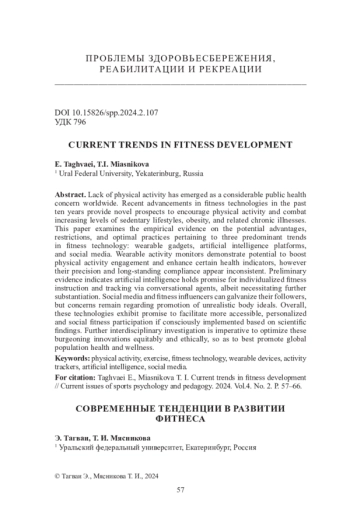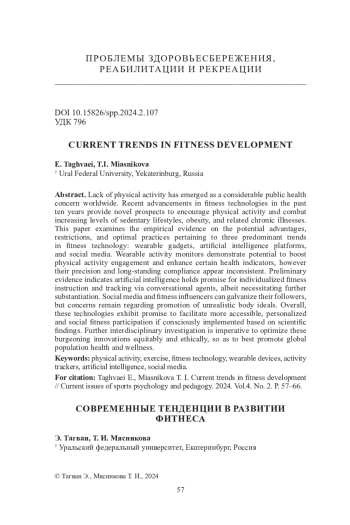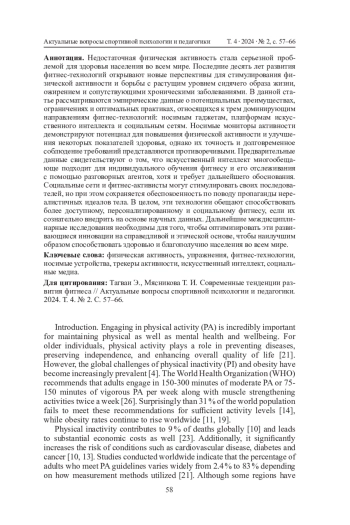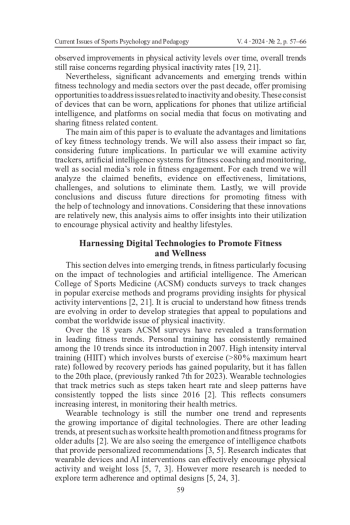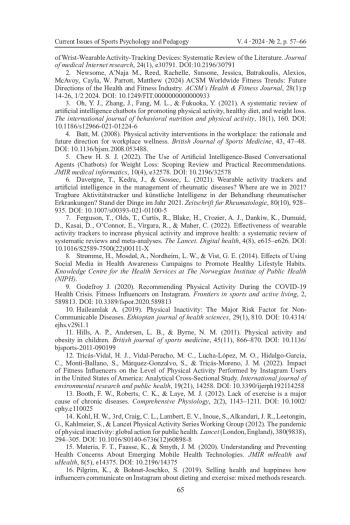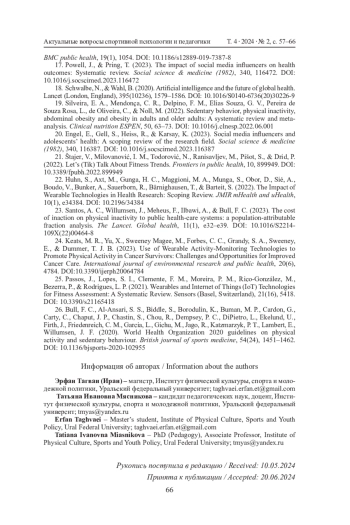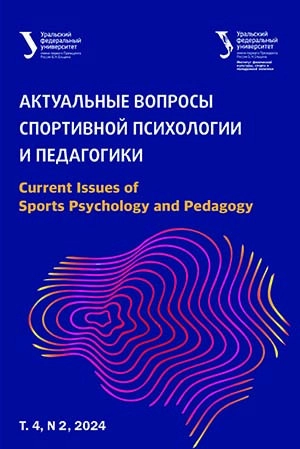Lack of physical activity has emerged as a considerable public health concern worldwide. Recent advancements in fitness technologies in the past ten years provide novel prospects to encourage physical activity and combat increasing levels of sedentary lifestyles, obesity, and related chronic illnesses. This paper examines the empirical evidence on the potential advantages, restrictions, and optimal practices pertaining to three predominant trends in fitness technology: wearable gadgets, artificial intelligence platforms, and social media. Wearable activity monitors demonstrate potential to boost physical activity engagement and enhance certain health indicators, however their precision and long-standing compliance appear inconsistent. Preliminary evidence indicates artificial intelligence holds promise for individualized fitness instruction and tracking via conversational agents, albeit necessitating further substantiation. Social media and fitness influencers can galvanize their followers, but concerns remain regarding promotion of unrealistic body ideals. Overall, these technologies exhibit promise to facilitate more accessible, personalized and social fitness participation if consciously implemented based on scientific findings. Further interdisciplinary investigation is imperative to optimize these burgeoning innovations equitably and ethically, so as to best promote global population health and wellness.
Идентификаторы и классификаторы
Introduction. Engaging in physical activity (PA) is incredibly important for maintaining physical as well as mental health and wellbeing. For older individuals, physical activity plays a role in preventing diseases, preserving independence, and enhancing overall quality of life [21]. However, the global challenges of physical inactivity (PI) and obesity have become increasingly prevalent [4]. The World Health Organization (WHO) recommends that adults engage in 150-300 minutes of moderate PA or 75- 150 minutes of vigorous PA per week along with muscle strengthening activities twice a week [26]. Surprisingly than 31% of the world population fails to meet these recommendations for sufficient activity levels [14], while obesity rates continue to rise worldwide [11, 19].
Список литературы
1. Accuracy and Acceptability of Wrist-Wearable Activity-Tracking Devices: Systematic Review of the Literature / F. Germini et al. //Journal of medical Internet research. 2022. 24(1), e30791. DOI: 10.2196/30791 EDN: DSYACN
2. ACSM Worldwide Fitness Trends: Future Directions of the Health and Fitness Industry / Newsome, M. A’Naja et al. // ACSM’s Health & Fitness Journal. 2024. 28(1), P. 14-26,. DOI: 10.1249/FIT.0000000000000933
3. A systematic review of artificial intelligence chatbots for promoting physical activity, healthy diet, and weight loss / Y. J. Oh et al. // The international journal of behavioral nutrition and physical activity. 2021. 18(1), P.160. DOI: 10.1186/s12966-021-01224-6 EDN: BVNRJR
4. Batt M. Physical activity interventions in the workplace: the rationale and future direction for workplace wellness // British Journal of Sports Medicine. 2008. 43, P. 47-48. DOI: 10.1136/bjsm.2008.053488
5. Chew H. S. J. The Use of Artificial Intelligence-Based Conversational Agents (Chatbots) for Weight Loss: Scoping Review and Practical Recommendations // JMIR medical informatics. 2022. 10(4), e32578. DOI: 10.2196/32578 EDN: GWBCII
6. Davergne T., Kedra J., Gossec L. Wearable activity trackers and artificial intelligence in the management of rheumatic diseases? Where are we in 2021? Tragbare Aktivitätstracker und künstliche Intelligenz in der Behandlung rheumatischer Erkrankungen? Stand der Dinge im Jahr 2021// Zeitschrift fur Rheumatologie. 2021. № 80 (10), P. 928-935. DOI: 10.1007/s00393-021-01100-5 EDN: WYUGEG
7. Effectiveness of wearable activity trackers to increase physical activity and improve health: a systematic review of systematic reviews and meta-analyses / T. Ferguson et al. // The Lancet. Digital health. 2022. 4(8), P. e615-e626. DOI: 10.1016/S2589-7500(22)00111-X EDN: EBCSPZ
8. Effects of Using Social Media in Health Awareness Campaigns to Promote Healthy Lifestyle Habits // H. Strømme et al. //Knowledge Centre for the Health Services at The Norwegian Institute of Public Health (NIPH). 2014.
9. Godefroy J. Recommending Physical Activity During the COVID-19 Health Crisis. Fitness Influencers on Instagram //Frontiers in sports and active living. 2020. 2, 589813. DOI: 10.3389/fspor.2020.589813 EDN: CPLFMS
10. Haileamlak A. Physical Inactivity: The Major Risk Factor for Non-Communicable Diseases //Ethiopian journal of health sciences. 2019. 29(1), P.810. DOI: 10.4314/ejhs.v29i1.1
11. Hills A. P., Andersen L. B., Byrne N. M. Physical activity and obesity in children. British journal of sports medicine. 2011. 45(11), P. 866-870. DOI: 10.1136/bjsports-2011-090199
12. Impact of Fitness Influencers on the Level of Physical Activity Performed by Instagram Users in the United States of America: Analytical Cross-Sectional Study / H. J. Tricás-Vidal et al. // International journal of environmental research and public health, 2022. 19 (21), 14258. DOI: 10.3390/ijerph192114258 EDN: AUZGVR
13. Lack of exercise is a major cause of chronic diseases / F. W. Booth et al. // Comprehensive Physiology. 2012. 2(2), P. 1143-1211. DOI: 10.1002/cphy.c110025 EDN: NTJJCW
14. Lancet Physical Activity Series Working Group The pandemic of physical inactivity: global action for public health / H. W. Kohl et al //Lancet (London, England), 2012. 380(9838), P. 294-305. DOI: 10.1016/S0140-6736(12)60898-8
15. Materia F. T., Faasse K., Smyth J. M. Understanding and Preventing Health Concerns About Emerging Mobile Health Technologies // JMIR mHealth and uHealth. 2020. 8(5), e14375. DOI: 10.2196/14375 EDN: JUODUO
16. Pilgrim K., Bohnet-Joschko S. Selling health and happiness how influencers communicate on Instagram about dieting and exercise: mixed methods research // BMC public health. 2019. 19(1), 1054. DOI: 10.1186/s12889-019-7387-8 EDN: VTJFPS
17. Powell J., Pring T. The impact of social media influencers on health outcomes: Systematic review// Social science & medicine (1982). 2023. 340, 116472. 10.1016/j.socscimed. 2023.116472. DOI: 10.1016/j.socscimed.2023.116472 EDN: QTXMSO
18. Schwalbe N., Wahl B. Artificial intelligence and the future of global health. Lancet (London, England). 2020. 395(10236). P. 1579-1586. DOI: 10.1016/S0140-6736(20)30226-9
19. Sedentary behavior, physical inactivity, abdominal obesity and obesity in adults and older adults: A systematic review and meta-analysis / E. A. Silveira et al. // Clinical nutrition ESPEN, 2022. 50, P. 63-73. DOI: 10.1016/j.clnesp.2022.06.001 EDN: KGHEBY
20. Social media influencers and adolescents’ health: A scoping review of the research field / E. Engel. et.al. // Social science & medicine (1982). 2023. 340, 116387. 10.1016/ j.socscimed.2023.116387. DOI: 10.1016/j.socscimed.2023.116387 EDN: PUEEHM
21. Talk About Fitness Trends / V. Štajer et al. // Frontiers in public health. 2022. 10, 899949. DOI: 10.3389/fpubh.2022.899949
22. The Impact of Wearable Technologies in Health Research: Scoping Review/ S. Huhn et al. //JMIR mHealth and uHealth. 2022. 10(1), e34384. DOI: 10.2196/34384 EDN: AABRTJ
23. The cost of inaction on physical inactivity to public health-care systems: a population-attributable fraction analysis / A. C. Santos et al. //The Lancet. Global health 2023. 11(1), e32-e39. DOI: 10.1016/S2214-109X(22)00464-8 EDN: KPAANO
24. Use of Wearable Activity-Monitoring Technologies to Promote Physical Activity in Cancer Survivors: Challenges and Opportunities for Improved Cancer Care / M. R. Keats et al. // International journal of environmental research and public health 2023. 20(6), 4784. DOI: 10.3390/ijerph20064784 EDN: ETECTK
25. Wearables and Internet of Things (IoT) Technologies for Fitness Assessment: A Systematic Review / J. Passos et al. // Sensors (Basel, Switzerland). 2021. 21(16), 5418. DOI: 10.3390/s21165418 EDN: UWVHSN
26. World Health Organization 2020 guidelines on physical activity and sedentary behavior / F. C. Bull et al. //British journal of sports medicine, (2020). 54(24), P. 1451-1462. DOI: 10.1136/bjsports-2020-102955
Выпуск
Другие статьи выпуска
Статья посвящена плаванию, как универсальному виду спорта, оказывающему положительный эффект на состояние всего организма человека. Использование оздоровительного плавания в качестве надежного профилактического средства, позволяет оказывать оздоровительное воздействие именно на те функциональные системы организма, которые в большей степени подвержены заболеваниям в студенческой среде. Было проведено исследование влияния плавания на функциональные показатели сердечно-сосудистой и дыхательной систем студентов, занимающихся самостоятельно и в секции. В исследовании приняли участие студенты Уральского федерального университета. Выявлено, что студенты, занимающиеся в секции, при занятиях плаванием имеют более благоприятные условия для комплексного воздействия на организм, чем студенты занимающиеся плаванием самостоятельно, за счет большей нагрузки во время тренировок и их систематичности.
Изучение проблемы самореализации в спорте предполагает анализ субъективного опыта спортсменов высокого уровня спортивного мастерства. Цель данной работы заключалась в опросе спортсменов-велошоссейников относительно их взглядов на личностную самореализацию. Выборку составили 20 спортсменов, имеющих звания кандидатов в мастера спорта (КМС), мастеров спорта (ММС), мастеров спорта международного класса (МСМК) и заслуженные мастера спорта (ЗМС). Для опроса была разработана анкета, включающая 22 вопроса. Анкета позволяла выявить: 1) цели и мотивацию спортсменов гонщиков; 2) удовлетворенность результатами деятельности; 3) самооценку собственных возможностей в достижении целей; 4) трудности, возникающие в процессе спортивной деятельности и готовность к их преодолению. Результаты исследования выявили различия во взглядах на спортсменов-велошоссейников в зависимости от уровня их спортивной квалификации и индивидуальных особенностей спортсменов. Полученные данные могут способствовать разработке стратегий психологического сопровождения спортсменов элитного уровня.
Компетентностный подход в конном спорте может способствовать повышению эффективности обучения. Цель исследования заключалась в разработке структуры и содержания компетенций спортсмена конника, а также методики их формирования. Результаты исследования включают примеры с описанием компетенций и тестовых заданий для их оценки. В качестве моделей базовых компетенций в подготовке спортсменов конников выделены: способность осуществлять грамотный уход за животным, способность седлать лошадь и корректировать амуницию, способность управлять выполнением лошадью базовых двигательных действий. Содержание каждой из указанных компетенций структурировано в виде компонентов: знание, понимание, умение. Предлагаемый педагогический инструментарий количественной оценки уровня сформированности компетенций и личностных качеств может быть использован в подготовке тренеров по конному спорту.
Занятия конным спорт могут быть успешными только при эффективном взаимодействии и сотрудничестве человека и лошади, поэтому личностные характеристики спортсменов -конников и их мотивация могут иметь свои специфические особенности. Цель исследования заключалась в изучении мотивов к занятиям конным спортом. В опытно-экспериментальном исследовании приняло участие 10 спортсменов-конников, средний возраст 24 года, имеющие стаж занятий от 5 до 24 лет. При исследовании мотивов использовалась шкала Лайкерата. В ходе исследования проведено сравнение значимости 6 группы мотивов, связанных со спортивным совершенствованием и построением карьеры, здоровьем и рекреацией, физическим и личностным развитием, социальным взаимодействием, направленностью на взаимодействие «всадник-лошадь», переживание удовольствия, связанного с эмоциональностью и зрелищностью конного спорта. Результаты исследования выявили, что наиболее значимыми мотивами у спортсменов-конников являются специфические мотивы. Дальнейшие исследования могут быть направлены на изучение мотивов занятий конным спортом в зависимости от возраста, уровня спортивного мастерства и квалификации спортсменов, а также разработка педагогических стратегий по их формированию.
Психологическая подготовка юных бадминтонистов предполагает изучение факторов, влияющих на их готовность к соревновательной деятельности. Цель исследования заключалась в выявлении взаимосвязи между тревожностью спортсменов бадминтонистов 12-13 лет и готовностью к соревновательной деятельности. В исследовании приняли участие 10 бадминтонистов 12-13 лет, имеющих спортивный стаж от 3 до 4 лет. Было проведено исследование на основе теста Спилберга-Ханина и теста Р. Мартенса «CSAI-2». Выявлено, что уровень тревожности юных бадминтонистов повышается в соревновательный период. Корреляционный анализ позволил выявить, что умеренная положительная взаимосвязь наблюдается между ситуативной и личностной тревожностью, когнитивной и личностной тревожностью, умеренная отрицательная взаимосвязь выявлена между личностной тревожностью и уверенностью в себе, а также соматической тревожностью и уверенностью в себе. Доказано, что влияние тревожности не является ключевым фактором, определяющим готовность к соревновательной деятельности. Дальнейшие исследования могут быть направлены на изучение индивидуальных личностных характеристик юных бадминтонистов 12-13 лет влияющих на предстартовую готовность.
Статистика статьи
Статистика просмотров за 2025 год.
Издательство
- Издательство
- УрФУ
- Регион
- Россия, Екатеринбург
- Почтовый адрес
- 620002, Свердловская область, г. Екатеринбург, ул. Мира, д. 19
- Юр. адрес
- 620002, Свердловская область, г. Екатеринбург, ул. Мира, д. 19
- ФИО
- Кокшаров Виктор Анатольевич (Ректор)
- E-mail адрес
- rector@urfu.ru
- Контактный телефон
- +7 (343) 3754507
- Сайт
- https://urfu.ru/ru
